Mitochondrial Fragmentation Promotes Inflammation Resolution Responses in Macrophages via Histone Lactylation
- PMID: 37807652
- PMCID: PMC10569354
- DOI: 10.1080/10985549.2023.2253131
Mitochondrial Fragmentation Promotes Inflammation Resolution Responses in Macrophages via Histone Lactylation
Abstract
During the inflammatory response, macrophage phenotypes can be broadly classified as pro-inflammatory/classically activated "M1", or pro-resolving/alternatively "M2" macrophages. Although the classification of macrophages is general and assumes there are distinct phenotypes, in reality macrophages exist across a spectrum and must transform from a pro-inflammatory state to a proresolving state following an inflammatory insult. To adapt to changing metabolic needs of the cell, mitochondria undergo fusion and fission, which have important implications for cell fate and function. We hypothesized that mitochondrial fission and fusion directly contribute to macrophage function during the pro-inflammatory and proresolving phases. In the present study, we find that mitochondrial length directly contributes to macrophage phenotype, primarily during the transition from a pro-inflammatory to a proresolving state. Phenocopying the elongated mitochondrial network (by disabling the fission machinery using siRNA) leads to a baseline reduction in the inflammatory marker IL-1β, but a normal inflammatory response to LPS, similar to control macrophages. In contrast, in macrophages with a phenocopied fragmented phenotype (by disabling the fusion machinery using siRNA) there is a heightened inflammatory response to LPS and increased signaling through the ATF4/c-Jun transcriptional axis compared to control macrophages. Importantly, macrophages with a fragmented mitochondrial phenotype show increased expression of proresolving mediator arginase 1 and increased phagocytic capacity. Promoting mitochondrial fragmentation caused an increase in cellular lactate, and an increase in histone lactylation which caused an increase in arginase 1 expression. These studies demonstrate that a fragmented mitochondrial phenotype is critical for the proresolving response in macrophages and specifically drive epigenetic changes via lactylation of histones following an inflammatory insult.
Keywords: fission; fusion; histone lactylation; inflammation resolution; macrophages; mitochondrial metabolism.
Conflict of interest statement
No potential conflict of interest was reported by the author(s).
Figures

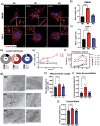
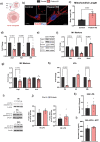
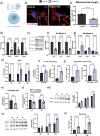
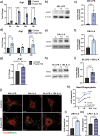
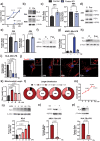
Similar articles
-
Histone lactylation in macrophage biology and disease: from plasticity regulation to therapeutic implications.EBioMedicine. 2025 Jan;111:105502. doi: 10.1016/j.ebiom.2024.105502. Epub 2024 Dec 10. EBioMedicine. 2025. PMID: 39662177 Free PMC article. Review.
-
In vitro evaluation of inhibitory effect of nuclear factor-kappaB activity by small interfering RNA on pro-tumor characteristics of M2-like macrophages.Biol Pharm Bull. 2014;37(1):137-44. doi: 10.1248/bpb.b13-00659. Epub 2013 Oct 19. Biol Pharm Bull. 2014. PMID: 24141263
-
Pyropia yezoensis glycoprotein promotes the M1 to M2 macrophage phenotypic switch via the STAT3 and STAT6 transcription factors.Int J Mol Med. 2016 Aug;38(2):666-74. doi: 10.3892/ijmm.2016.2656. Epub 2016 Jun 24. Int J Mol Med. 2016. PMID: 27353313
-
Histone Lactylation Boosts Reparative Gene Activation Post-Myocardial Infarction.Circ Res. 2022 Nov 11;131(11):893-908. doi: 10.1161/CIRCRESAHA.122.320488. Epub 2022 Oct 21. Circ Res. 2022. PMID: 36268709
-
Macrophage plasticity, polarization, and function in health and disease.J Cell Physiol. 2018 Sep;233(9):6425-6440. doi: 10.1002/jcp.26429. Epub 2018 Mar 1. J Cell Physiol. 2018. PMID: 29319160 Review.
Cited by
-
Regulation of macrophage activation by lactylation in lung disease.Front Immunol. 2024 Jul 4;15:1427739. doi: 10.3389/fimmu.2024.1427739. eCollection 2024. Front Immunol. 2024. PMID: 39026681 Free PMC article. Review.
-
Histone lactylation in macrophage biology and disease: from plasticity regulation to therapeutic implications.EBioMedicine. 2025 Jan;111:105502. doi: 10.1016/j.ebiom.2024.105502. Epub 2024 Dec 10. EBioMedicine. 2025. PMID: 39662177 Free PMC article. Review.
-
Basic Mechanisms of Immunometabolites in Shaping the Immune Response.J Innate Immun. 2023;15(1):925-943. doi: 10.1159/000535452. Epub 2023 Nov 23. J Innate Immun. 2023. PMID: 37995666 Free PMC article. Review.
-
Mitochondrial metabolic regulation of macrophage polarization in osteomyelitis and other orthopedic disorders: mechanisms and therapeutic opportunities.Front Cell Dev Biol. 2025 Jun 13;13:1604320. doi: 10.3389/fcell.2025.1604320. eCollection 2025. Front Cell Dev Biol. 2025. PMID: 40584964 Free PMC article. Review.
-
The lactylation-macrophage interplay: implications for gastrointestinal disease therapeutics.Front Immunol. 2025 Jul 9;16:1608115. doi: 10.3389/fimmu.2025.1608115. eCollection 2025. Front Immunol. 2025. PMID: 40703527 Free PMC article. Review.
References
Publication types
MeSH terms
Substances
LinkOut - more resources
Full Text Sources
Research Materials
Miscellaneous
